The Huawei Honor 8 Review
by Matt Humrick on October 13, 2016 8:00 AM EST- Posted in
- Huawei
- Smartphones
- Mobile
- Kirin 950
- honor
System Performance
Inside the Honor 8 is a HiSilicon Kirin 950 SoC, with four ARM Cortex-A72 CPUs running at up to 2.304GHz and four Cortex-A53 CPUs running at up to 1.805GHz, paired with either 3GB or 4GB of LPDDR4 1333MHz RAM. We covered the Kirin 950’s performance and power efficiency in great detail in our Mate 8 review, so I will not delve into that again here. If you’re the curious type and have not already seen that review, it’s a very interesting read.
Like most recent devices, the Honor 8 offers a few different battery modes: Performance, Smart, and Ultra. The first mode obviously favors performance over battery life, while the Ultra mode severely limits the functionality of the phone—only allowing access to the dialer, messaging and contacts—and is only intended for situations when you really need to stretch battery life. The Smart mode, which is selected by default, tries to extend battery life by limiting peak performance in a way that does not noticeably degrade the user experience. Based on a casual investigation, there does not seem to be an obvious difference in how the Performance and Smart modes handle the A72 cores, but the Smart mode drops the target frequency for the A53 cores in moderate workloads from 1.5GHz to 1.3GHz. In order to see what effect this has on performance and battery life, I ran PCMark using both modes. All of the other tests use Performance mode.
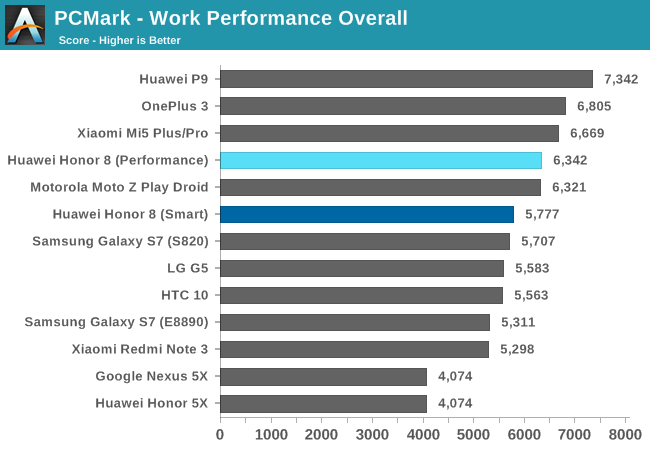
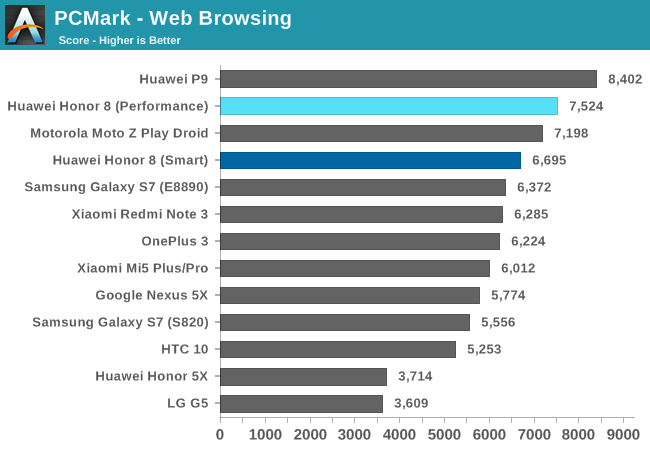
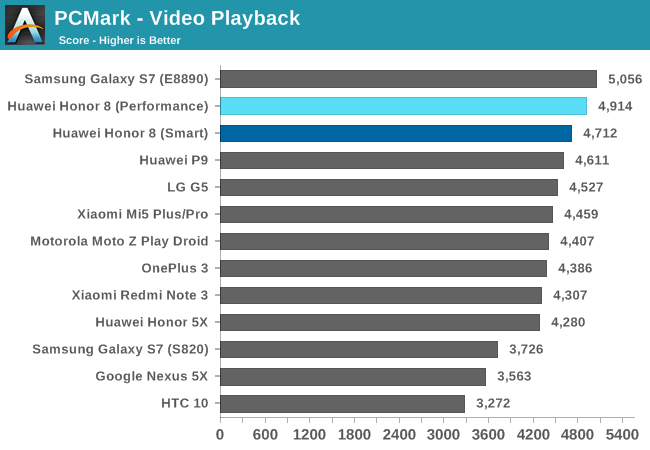
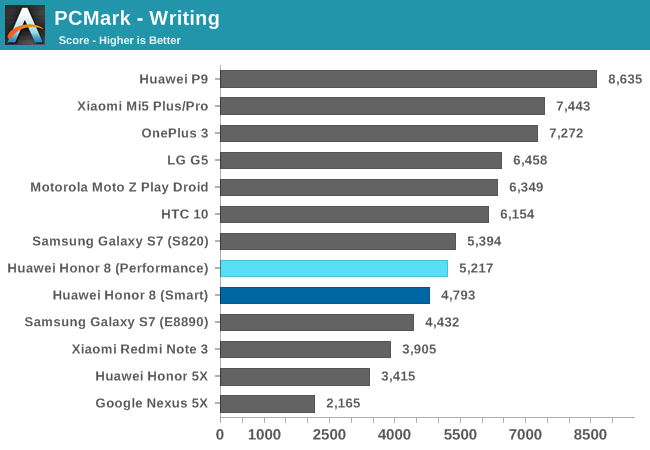
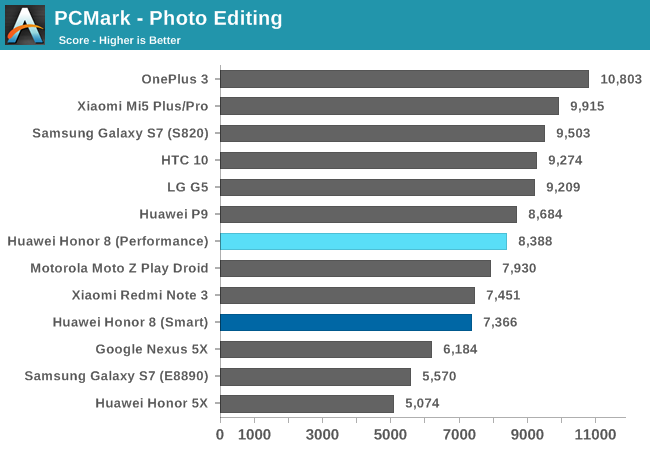
PCMark evaluates overall system performance by running real-world workloads that exercise the CPU, GPU, RAM, and NAND storage. Instead of running synthetic micro-benchmarks that run the CPU(s) only at peak frequency, its workloads rely on the same Android API calls many common apps use, eliciting realistic behavior from the CPU governor.
The Honor 8 finds itself surrounded by phones running Qualcomm’s Snapdragon 820 SoC in this test, at least when looking at the overall score; however, it fails to achieve the same level of performance as Huawei’s flagships, the Mate 8 and P9. Even more curious, though, is how phones with “5X” in their name manage to achieve the same score, and how the Moto Z Play Droid, with its mid-range Qualcomm Snapdragon 625 SoC that only uses A53 CPUs, matches the overall performance of the Honor 8. Just because an SoC uses a CPU with a more sophisticated architecture or reaches higher peak frequencies does not guarantee superior performance. There are many parameters OEMs can adjust in software that impact user experience.
This becomes obvious in the Web Browsing test where the overachieving Moto Z Play outperforms the Snapdragon 820 phones and even the Galaxy S7 with Exynos 8890. The Honor 8 and Huawei P9 do even better in this test, with the Honor 8 scoring 18% higher than the Galaxy S7 (Exynos 8890) and a more substantial 43% higher than the HTC 10 in Performance mode. Switching the Honor 8 into Smart mode reduces its score by 11%, which is not unexpected based on the small reduction in frequency for the A53 cores.
The only place where the Honor 8 falters a bit is in the Writing test, which is very sensitive to how aggressively the CPU governor utilizes the high-performance cores. With this workload, the Honor 8 slots in between the two different versions of the Galaxy S7 and falls behind the Snapdragon 820 phones such as the HTC 10 and OnePlus 3. Because this workload makes better use of the A72 cores, switching the Honor 8 into Smart mode only reduces performance by 8%.
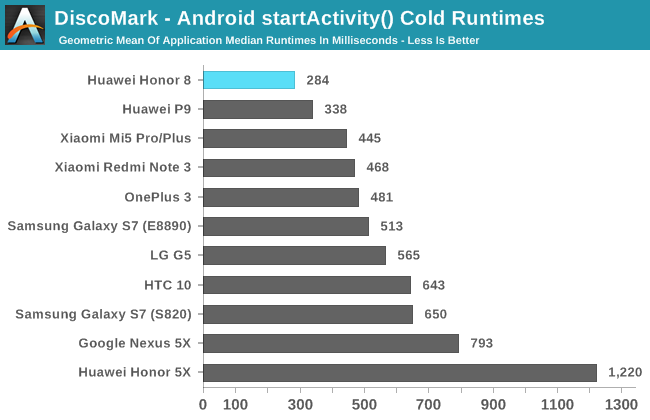
DiscoMark measures application launch times by taking advantage of Android's accessibility services to monitor an application’s startActivity() method, and the cold launch test reflects how quickly a phone opens apps from internal storage.
It’s interesting to see the phones from Huawei and Xiaomi perform so well. Except for the Nexus 5X and Honor 5X, all of the phones on this chart feel reasonably fast when opening apps, but with the Honor 8, it feels nearly instantaneous in some cases, opening this particular subset of apps 41% faster than the OnePlus 3 and 56% faster than the Galaxy S7 (Snapdragon 820).
These results illustrate that there’s more to this test than NAND or CPU performance. Just like with PCMark, software tuning plays a significant role here too. For example, Huawei mentions its “smart file-processing system” that aims to deliver a smoother user experience. While a system implies many different parts, one thing it seems to employ is more aggressive filesystem caching in the kernel. All modern operating systems, including Android, will cache disk reads and writes in a RAM cache to hide or reduce the latency of accessing internal storage. By using a larger cache, it’s more likely it will still hold a portion of the app’s code in RAM, bypassing the NAND and speeding up launch times.
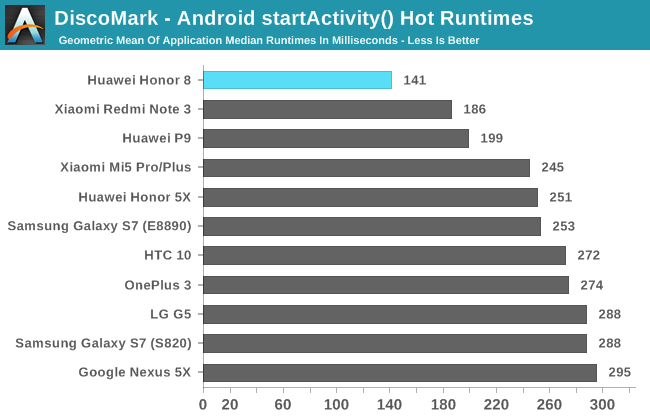
When switching between apps that are already open and sitting in RAM, the Honor 8, along with Huawei’s and Xiaomi’s other phones, rise to the top of our chart once again. Even the Huawei Honor 5X, a lower-cost phone with a Snapdragon 616 SoC and 2GB of LPDDR3 RAM, finishes ahead of the latest flagship devices. Differences here are less noticeable, however, because all of these phones switch between apps quickly.
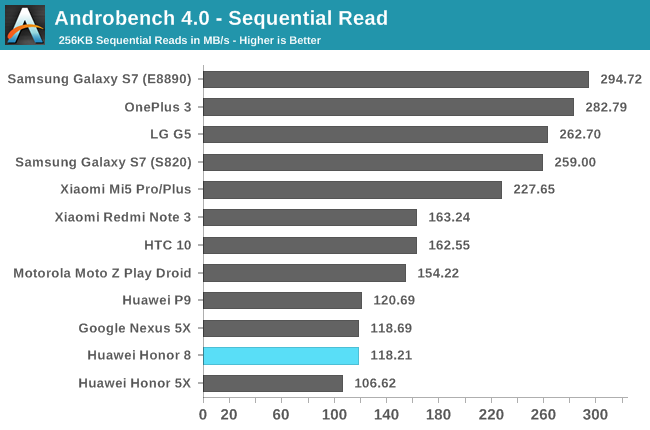
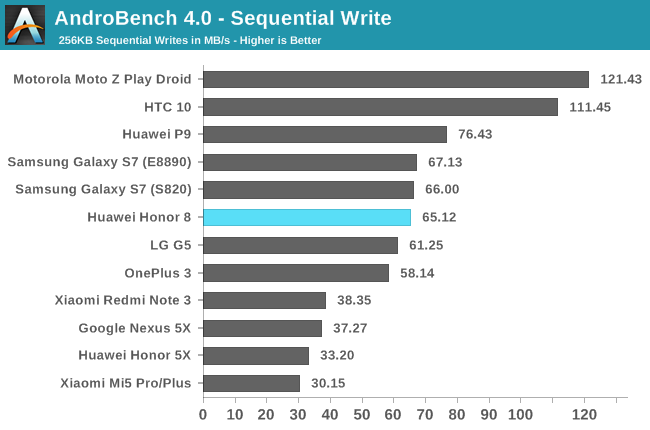
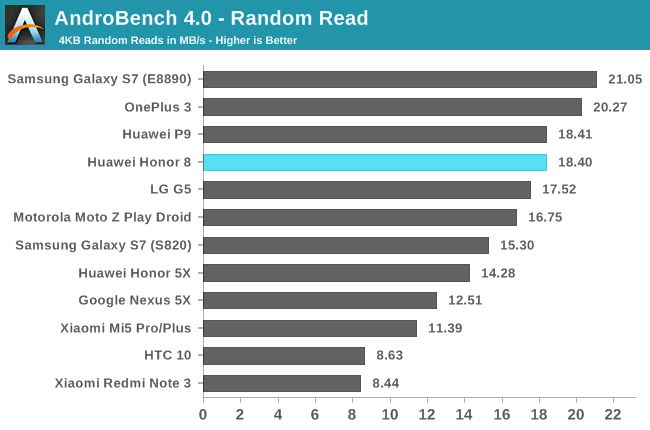
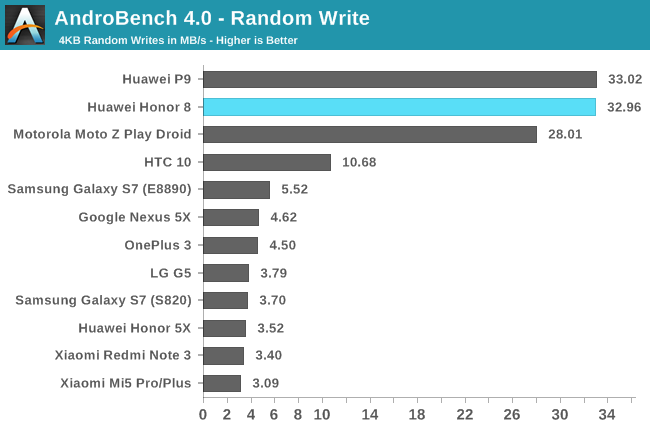
In our synthetic storage test, the sequential read performance of Huawei’s Honor 8, Honor 5X, and P9 is uninspiring, barely passing 120 MB/s when most flagship Android devices are hitting 250 MB/s to 300 MB/s. Sequential write performance is about average, matching the Galaxy S7.
Huawei seems more concerned with random performance; both the Honor 8 and P9 handle 4KB random reads and writes quite well. Their random write speed really stands out, performing 3x better than the HTC 10 and more than 7x better than the OnePlus 3.
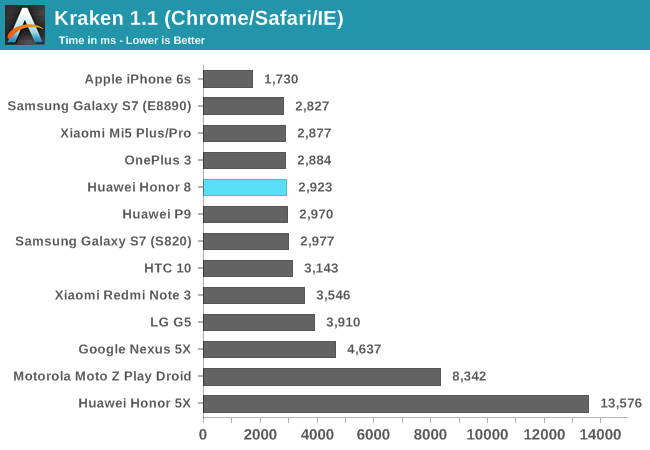
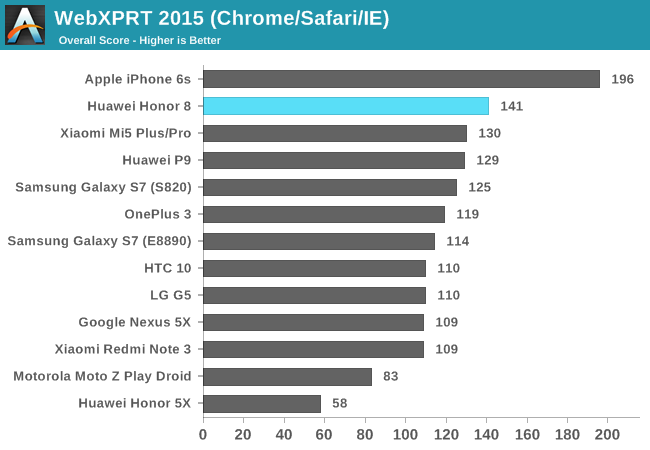

The Honor 8’s ARM CPUs perform well in our browser JavaScript tests. It’s on par with the current Android flagships in Kraken and holds a small advantage over the Snapdragon 820 phones in WebXPRT 2015 and JetStream.
My subjective experience with the Honor 8 confirms the data above: The Honor 8 is a fast phone. It handles common tasks such as opening and switching between apps, loading and scrolling web pages in the browser, and searching the inbox for an email with ease. The user interface remains buttery smooth while scrolling through home screens, opening and scrolling the task switcher, and pulling down the notification shade. It will drop a frame or two when you first interact with an object, say grab the notification shade or tap an icon, but the pause is so brief that it’s basically imperceptible to the human eye. Huawei has done a good job optimizing the Honor 8’s performance.


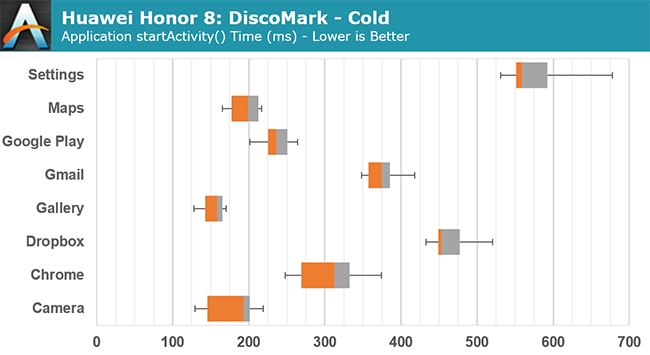
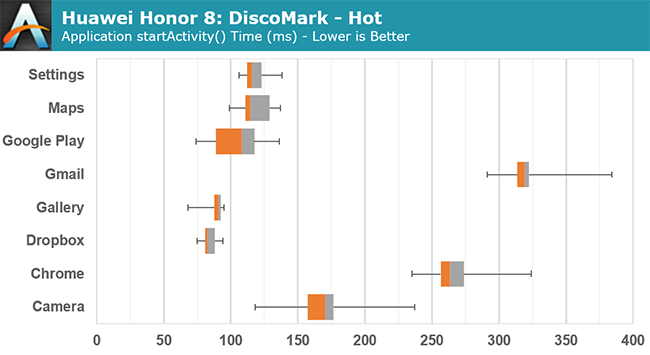








95 Comments
View All Comments
Matt Humrick - Friday, October 14, 2016 - link
That's a good point. The Smart mode selectively reduces screen brightness when using specific apps. It does not alter screen brightness for the PCMark test, which is one reason why there is not a bigger gap between it and the Performance mode; however, it does drop brightness from the calibrated 200 nits to about 100 nits when using the Chrome browser, which would increase the battery life in our web browsing battery life tests (these were run in Performance mode).prku - Friday, October 14, 2016 - link
Honor 8 is not a dual-standby dual sim phone. Please check again. it is supposed to have Dual Sim Full Active (which is a major selling point). DSFA is supposed to be present in all but Indian variations of the Honor.randomlm - Saturday, October 15, 2016 - link
Thanks for the nicely written, well balanced and non-biased review matt. This is the standard I've come to expect from anandtech that imo, some other reviewer on this site hasn't been delivering, especially on the camera portion of the review.Of course, entirely just my opinion
Feegenie - Saturday, October 15, 2016 - link
Fair.........jvl - Saturday, October 15, 2016 - link
"It’s a bit unfair to point our fingers solely at the OEMs and carriers, of course, because it was Google that created this mess and, ultimately, only Google can clean it up."What.
lagittaja - Saturday, October 29, 2016 - link
Do you even Android? Version distribution. Google can't force OEM's or carriers to update the devices.Even Android N's "auto update" doesn't really fix anything.
Why would the carrier or OEM keep updating the devices if they can just drag their feet on the ground making the update process as slow and painful as possible or just flat out not update them? Even once? The consumer will just buy a new device anyway.
Between 29th Aug and 5th Sept, of all the devices "phoning home" to Google a whopping 81.3% were running Android Lollipop 5.1 or older version.
If you take Lollipop out of the equation, 46.3% of the devices were running KitKat 4.4 or older.
If you take KitKat out of the equation, still almost 20% of the devices were running Jelly Bean 4.3 or older..
https://developer.android.com/about/dashboards/ind...
http://www.infoworld.com/article/3072591/android/g...
Google even tried to downplay the issue during May I/O event saying "it's not fragmented".
https://data.apteligent.com/download-report?report...
Yeah, that looks SO much better... 80%+ of devices being used are running Lollipop or older. A third of the devices being used are running KitKat or older..
And saying yeah, well only KitKat, Lollipop and Marshmallow matter because reasons and hey look at that 92% of devices being "used" are running Android OS's that "matter" and oh hey in contrast to iOS there's only iOS8 and iOS9 that matter and oh hey that comprises 97% of the iOS traffic. We're just as good as Apple! Yey us!
Uhm no.. Apple keeps it tidy because they have CONTROL...
iOS 9 only runs on devices that are from 2011 or older.
iOS 10 only runs on devices that are from 2012 or older.
Google has no control what so ever of Android devices that are not made by them.
Bloody hell, there's still Android devices sold new that run KitKat. And guess what, most of them are not going to receive a single damng update because the OEM doesn't give a flying fuck about it.
Look at Apple, look at what devices they sell. Guess what, they run iOS 10 or are just waiting to be turned on so they can nag you that there's a pending update.
With Android Nougat Google should have grabbed the "bull by the horns" and just fix the God damn problem.
They should have made a way for them to be able to at least deliver the critical security updates to the devices "automagically" no matter what sort of customizations OEM's or carriers have done.
I don't have the faintest idea of how that could be done but it's the least that needs to be done.
P.S. I'm an Android user and always will be. I don't like Apple's devices or their OS but I like how good control they have over their devices.
phuzi0n - Sunday, October 16, 2016 - link
Is this a phone review or a car review? We could do without all the car analogies in the first three paragraphs.Badelhas - Sunday, October 16, 2016 - link
I hate these Chinese UI skins which are iPhone iOS imitations. But that's just me.nkuehn - Friday, October 21, 2016 - link
Matt, did you also do testing on the Cellular Performance? Anandtech is famously good at really testing and not just testin, but I'm totally missing this part. I'm asking because some other reviewers had serious issues with the LTE performance of the device, losing LTE connection in well covered area etc.Maybe partner with people like http://cellularinsights.com/ - they have the testing hardware for cell that you have for displays and all the other stuff.
Savanah - Thursday, October 27, 2016 - link
I am so glad I went for the Moto Z Play instead of the Oneplus 3. It has a premium build quality, great display, awesome battery life, buttery smooth performance and decent cameras. It also excels in areas we tend to take for granted like call quality and signal retention. And to top it off it is bound to get fastest Android updates of any non Nexus/Pixel device. What else can you wish for in a $350 smart phone?